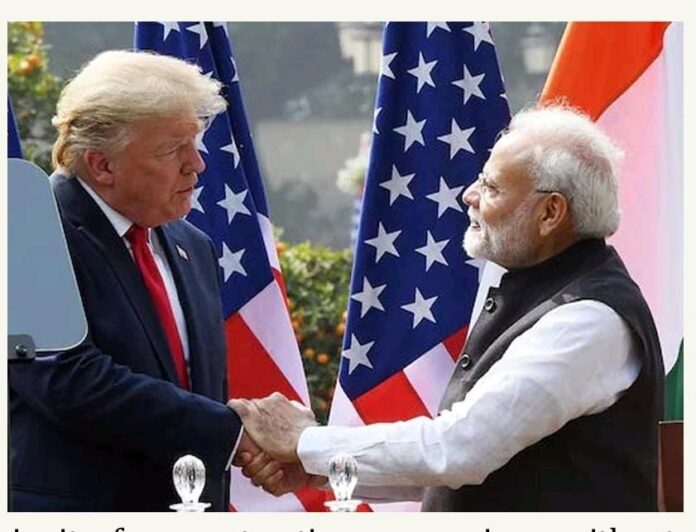Shivaji Sarkar

The recent meeting between Prime Minister Narendra Modi and President Donald Trump has ignited a significant debate on the trajectory of India-US trade relations. The ambitious target to double bilateral trade to $500 billion by 2030, coupled with discussions on key sectors such as artificial intelligence, semiconductors, and strategic minerals, has been met with a mix of optimism and scepticism. While the commitment to a mutually beneficial trade agreement signals a new chapter in economic cooperation, concerns regarding tariffs, trade imbalances, and geopolitical considerations persist.
One of the most critical aspects of this agreement is the potential for increased market access and the reduction of tariff and non-tariff barriers. For India, this could mean a boost in exports, especially in sectors such as pharmaceuticals, IT services, and engineering goods. Similarly, the US could benefit from greater access to India’s growing consumer market, particularly in areas like agriculture, energy, and defence. A more integrated supply chain between the two countries could significantly enhance economic growth and trade efficiency, benefiting industries on both sides.
However, despite these potential benefits, Trump’s insistence on reciprocal tariffs has emerged as a contentious issue. The disparity in tariff rates, with the US charging an average of 3% on imports from India compared to India’s 9.5% on imports from the US, has long been a point of friction. Trump has been vocal about reducing this imbalance, arguing that American businesses face unfair disadvantages when trading with India. His stance on implementing reciprocal tariffs could hit Indian exports hard, particularly in labour-intensive sectors like textiles, garments, and footwear, which thrive on cost competitiveness.
Economic experts remain divided on the impact of such measures. Ajay Srivastava, founder of the Global Trade Research Initiative (GTRI), argues that reciprocal tariffs may not have a substantial effect on India due to differences in export compositions. The US primarily exports high-tech goods, defence equipment, and agricultural products, while India’s exports are more focused on pharmaceuticals, IT services, and manufacturing. This suggests that tariff adjustments alone may not significantly alter trade flows. However, Srivastava also acknowledges that high US tariffs on Indian goods could pose challenges, particularly for small and medium enterprises that rely on competitive pricing.
On the other hand, Sonal Varma, Chief Economist for India and Asia, ex-Japan at Nomura, suggests that India may have to reduce tariffs on over 30 items and increase its purchases of US defence and energy products to secure a trade deal. This raises concerns about India’s economic sovereignty and the potential burden on domestic industries. While greater defence and energy cooperation with the US could bolster India’s strategic positioning, excessive dependence on American imports may undermine India’s long-term trade interests.
Beyond economics, the geopolitical implications of this trade agreement are profound. The US has been actively working to counter China’s influence in the Indo-Pacific region, and strengthening ties with India is a crucial part of this strategy. The potential sale of F-35 fighter jets to India and increased military collaboration reflect the strategic depth of this partnership. A stronger US-India trade relationship could bolster India’s defence capabilities and contribute to regional stability. However, if India is seen as aligning too closely with the US, it risks antagonizing China, which remains a major trade partner and regional power.
At the same time, the imposition of reciprocal tariffs could strain diplomatic relations and lead to retaliatory measures from India. New Delhi has already shown its willingness to respond to US trade policies by imposing tariffs on American products in the past. If the US continues to press India for unilateral concessions, it could lead to a cycle of retaliatory tariffs, ultimately harming businesses and consumers in both countries. The challenge lies in striking a balance that preserves India’s economic interests while fostering deeper cooperation with the US.
Another critical aspect of the debate is the role of domestic political considerations in shaping trade policy. For Trump, adopting a hardline stance on trade is a key part of his broader “America First” strategy. By pushing for stricter trade terms with India, he aims to appeal to his voter base, particularly those in manufacturing and agricultural sectors that feel disadvantaged by global trade imbalances. For Modi, strengthening economic ties with the US is essential for India’s long-term growth ambitions, but he also faces pressure from domestic industries that fear losing their competitive edge due to reduced tariffs and increased foreign competition.
The road ahead for India-US trade relations is fraught with complexities. While both leaders have expressed their commitment to a stronger economic partnership, the practical challenges of negotiating a fair and balanced agreement remain. Tariff adjustments, trade imbalances, and geopolitical considerations must be carefully managed to ensure that the agreement benefits both nations without disproportionately disadvantageing one over the other. The success of this trade deal will ultimately depend on the ability of India and the US to navigate these challenges with a pragmatic and strategic approach, ensuring that economic cooperation does not come at the cost of national interests.


